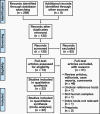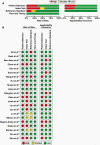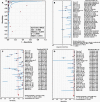Evaluation of RT-LAMP Assay for Rapid Detection of SARS-CoV-2
- PMID: 35849098
- PMCID: PMC9384514
- DOI: 10.1093/labmed/lmac030
Evaluation of RT-LAMP Assay for Rapid Detection of SARS-CoV-2
Abstract
Objective: To evaluate the accuracy of the reverse transcription loop-mediated isothermal amplification (RT-LAMP) assay for rapid detection of severe acute respiratory syndrome coronavirus 2 (SARS-CoV-2) in community or primary-care settings.
Method: We systematically searched the Web of Science, Embase, PubMed, and Cochrane Library databases. We conducted quality evaluation using ReviewManager software (version 5.0). We then used MetaDisc software (version 1.4) and Stata software (version 12.0) to build forest plots, along with a Deeks funnel plot and a bivariate boxplot for analysis.
Result: Overall, the sensitivity, specificity, and diagnostic odds ratio were 0.79, 0.97, and 328.18, respectively. The sensitivity for the subgroup with RNA extraction appeared to be higher, at 0.88 (0.86-0.90), compared to the subgroup without RNA extraction, at 0.50 (0.45-0.55), with no significant difference in specificity.
Conclusion: RT-LAMP assay exhibited high specificity regarding current SARS-CoV-2 infection. However, its overall sensitivity was relatively moderate. Extracting RNA was found to be beneficial in improving sensitivity.
Keywords: COVID-19; COVID-19 diagnostic testing; LAMP assay; SARS-CoV-2; meta-analysis; severe acute respiratory syndrome coronavirus 2.
© The Author(s) 2022. Published by Oxford University Press on behalf of American Society for Clinical Pathology. All rights reserved. For permissions, please e-mail: journals.permissions@oup.com.
Figures





Similar articles
-
A Multiplex and Colorimetric Reverse Transcription Loop-Mediated Isothermal Amplification Assay for Sensitive and Rapid Detection of Novel SARS-CoV-2.Front Cell Infect Microbiol. 2021 Jun 29;11:653616. doi: 10.3389/fcimb.2021.653616. eCollection 2021. Front Cell Infect Microbiol. 2021. PMID: 34268131 Free PMC article.
-
Development and Clinical Application of a Rapid and Sensitive Loop-Mediated Isothermal Amplification Test for SARS-CoV-2 Infection.mSphere. 2020 Aug 26;5(4):e00808-20. doi: 10.1128/mSphere.00808-20. mSphere. 2020. PMID: 32848011 Free PMC article.
-
Colorimetric reverse transcription loop-mediated isothermal amplification (RT-LAMP) as a visual diagnostic platform for the detection of the emerging coronavirus SARS-CoV-2.Analyst. 2021 Jan 21;146(2):471-477. doi: 10.1039/d0an01775b. Epub 2020 Nov 9. Analyst. 2021. PMID: 33165486
-
Nucleic acid amplification tests on respiratory samples for the diagnosis of coronavirus infections: a systematic review and meta-analysis.Clin Microbiol Infect. 2021 Mar;27(3):341-351. doi: 10.1016/j.cmi.2020.11.002. Epub 2020 Nov 11. Clin Microbiol Infect. 2021. PMID: 33188933 Free PMC article.
-
Diagnostic efficiency of RT-LAMP integrated CRISPR-Cas technique for COVID-19: A systematic review and meta-analysis.Pathog Glob Health. 2022 Oct;116(7):410-420. doi: 10.1080/20477724.2022.2035625. Epub 2022 Feb 10. Pathog Glob Health. 2022. PMID: 35142264 Free PMC article.
Cited by
-
Quantitative mRNA expression measurement at home.Sci Rep. 2024 Jan 10;14(1):1013. doi: 10.1038/s41598-023-49651-8. Sci Rep. 2024. PMID: 38200031 Free PMC article.
-
Modeling a Standard Loop-Mediated Isothermal Amplification Reaction and Its Modification Involving Additional Inner Primers.Biomolecules. 2025 May 9;15(5):690. doi: 10.3390/biom15050690. Biomolecules. 2025. PMID: 40427583 Free PMC article.
-
Clinical Performance of the Reverse Transcription-Loop-Mediated Isothermal Amplification Assay for the Diagnosis of COVID-19 in a Thai Community Hospital at the Thailand-Myanmar Border.Cureus. 2024 Feb 19;16(2):e54447. doi: 10.7759/cureus.54447. eCollection 2024 Feb. Cureus. 2024. PMID: 38510857 Free PMC article.
-
Colorimetric RT-LAMP for SARS-CoV-2 detection from nasopharyngeal swabs or crude saliva: a multicountry diagnostic accuracy study in Africa.Lancet Glob Health. 2025 Jul;13(7):e1258-e1267. doi: 10.1016/S2214-109X(25)00150-0. Lancet Glob Health. 2025. PMID: 40580991 Free PMC article.
References
Publication types
MeSH terms
Substances
Supplementary concepts
LinkOut - more resources
Full Text Sources
Medical
Miscellaneous

